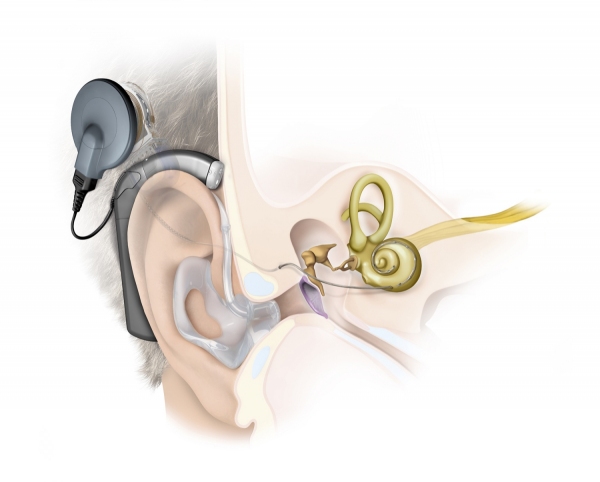You are here
See Media: https://otologypro.com.my/media
Hearing Aid vs Implant
A hearing aid works by delivering amplified environmental sounds into the ear canal helping restore hearing in conductive and sensorineural deafness. However if the cochlea is so dysfunctional (as in profound sensorineural deafness) that it cannot convert the amplified sound into a useable electrical signal for the hearing nerve to transmit to the brain (golden ribbon-like structure), a cochlear implant (electrode wire seen entering and coiling in the cochlea) can do the conversion and deliver the signal directly to the hearing nerve. This is a diagram of an Electric Acoustic Stimulation device which has a hearing aid to amplify low frequency sounds and a cochlear implant to amplify and deliver high frequency sounds simultaneously.

Active Implants
Active implants restore hearing loss in conductive deafness, mixed deafness, and because they are battery powered can also amplify sounds for a poorly functioning cochlea (sensorineural deafness). They have a button-like external microphone which is placed behind and above the ear and can be hidden within the hair. They leave the ear canal open and hence are like an invisible hearing aid. They may also help provide tinnitus relief (ringing in the ears).
Cochlear Implant
Testimonial from Mrs Bon Pei Woon whose son Kevin Mok Jia Wen underwent Cochlear Implant Surgery
If the hearing is severley to profoundly down usually only a Cochlear Implant can restore adequate hearing. This can be for deafness in one ear or both ears. In the case of children it can help them learn to speak as well as hear. The length of deafness is one of the main factors affecting successful hearing restoration. See Cochlear Implant.
Middle Ear Implant- A Hidden Solution for Clearer Hearing
The Vibrant Soundbridge Middle Ear Implant is suitable for patients with mild to severe sensorineural deafness, conductive deafness or mixed deafness. The implant directly stimulates the middle ear structures thus providing better hearing in noisy situations, with less noisiness and a more natural sound quality compared to hearing aids. It bypasses the ear canal and hence is also suitable for those with no / very narrow ear canals, or those who cannot tolerate an obstructed ear canal. See Middle Ear Implant.
Bonebridge Implant and Bone Anchored Hearing Aid (BAHA)
The Bonebridge Implant and Bone Anchored Hearing Aid (BAHA) are suitable for patients with single-sided deafness, conductive deafness, or mixed deafness. Both implants transmit sound to the cochlea via bone conduction thus bypassing the ear canal and the middle ear. They are an option for patients with no / very little hearing in one ear, patients with no / very narrow ear canals, or patients with hearing loss due to chronic middle ear disease not salvagable by other methods such as an Ossiculoplasty or a Middle Ear Implant. See Bonebridge or BAHA.
Passive Implants
If the middle ear bones do not conduct sound from the ear drum to the cochlea there is conductive deafness. This may happen if the bones have been worn away by disease or come apart from head trauma. Ossiculoplasty surgery involves the insertion of a tiny Titanium implant into the middle ear to replace the 2nd middle ear bone (Anvil), or to replace the 2nd and 3rd middle ear bones (Anvil and Stirrup). This restores the connection between the ear drum and the cochlea and restores hearing without the need for a hearing aid. If there is mixed deafness, depending on how much residual cochlea function there is the surgery may still do away with a hearing aid or at least produce better results with a hearing aid. See Ossiculoplasty.


